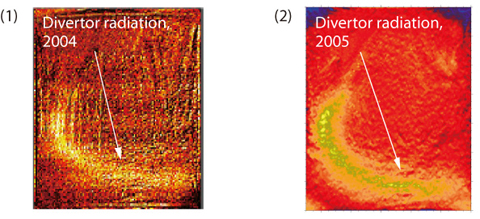Fig.3-10

Fig.3-11
A bolometer is an instrument to diagnose plasma radiation. A thin metal foil of the bolometer receives radiated power from the plasma, impurities and hydrogen being the primary radiators, and the resulting temperature rise of the foil is measured. So-called resistive bolometers have been used up until now. A resistor is attached on the back of the foil and the temperature is given as a function of that resistance. However, this method requires many detectors and electronic circuits. Recently, compact and advanced infrared (IR) cameras have become available. The foil temperature can be measured directly by an IR camera outside of the vacuum window. This is the IR imaging video bolometer, IRVB. The IRVB can provide a wide view equivalent to hundreds of resistive bolometers. In order to test IRVB feasibility under burning plasma conditions, an IRVB was installed on the JT-60U tokamak (Fig.3-10 (2)). The field of view (Fig.3-10 (1)) was designed to cover a wide area of the donut plasma by looking tangentially from an upper port of "JT-60U". The 2.5-micron gold foil in IRVB has proved to be durable for more than three years of tokamak operations. The brightest radiation, i.e. highest foil temperature image, is seen during an abrupt plasma termination called a disruption, as shown in Fig.3-10 (3). An enormously strong radiation belt was recorded on the foil when the high temperature plasma became a huge radiator. Under normal operation, radiated power peaks only near the target tiles of the divertor. A curved radiation belt along the divertor, a red line in Fig.3-10 (1), is visible on the foil in Fig.3-11. Improvement of the neutron shielding and digital data system allowed clearer images even during high power deuterium discharges. Radiated power from 1/4 of big donut plasma with diameter of 6 meters was taken successfully as an image. There has been no such attempt like this before. A simple unanswered question, whether tokamak radiation is uniform along the donut ring, can be addressed with this diagnostic. (This is a collaborative research between JAEA and the National Institute for Fusion Science and was partly supported by a Grant-in-Aid for Scientific Research from JSPS, Nos. 16560729 and 16082207.)